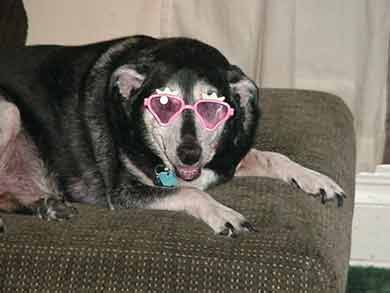Please Help Homeless Pets with a donation of one dollar
The Right way to Dental Care for your Dog
Dogs have 28 deciduous teeth (temporary) and 42 permanent teeth. Deciduous
or milk teeth begin to appear when a puppy is about four weeks of
age, and are lost gradually between 14 and 30 weeks of age. During this time,
puppies may eat slightly less and chew more. Hard rubber or rawhide toys made
especially for dogs are a good investment to help prevent household damage
during this time.
Common signs of dental problems in dogs include:
- Loss of appetite
- Red, swollen and bleeding gums
- Drooling
- Blood in the saliva
- Yellow-brown tartar at the gum line
- Broken teeth
- Foul breath
Dogs sometimes suffer from broken teeth, often a result of biting on sticks
or rocks. A cracked or broken tooth can be painful if the nerve tissue is
exposed; if it becomes infected, there is the danger of the infection
spreading through the bloodstream. Prompt veterinary attention is recommended.
Dog Dental Problems
To ensure your dog's dental health, they require dental care on a regular
basis. Otherwise they may develop problems.
Dog dental problems may also result from injury, foreign bodies such as
porcupine quills or foxtail, malnutrition or systemic diseases which infect
the mouth as well as other parts of the body.
Occasionally a puppy or kitten will retain some deciduous (baby) teeth
after the permanent teeth have appeared. This may damage the soft tissues of
the mouth and may even accelerate wear of permanent teeth. A veterinarian
should be consulted to determine whether or not removal is necessary.
The following is an excerpt from the American Kennel Club Dog Care and
Training Book.
"Dental hygiene is often ignored in the dog. The outcome? Consider
what your teeth might look and feel like after months, years or even a
lifetime of neglect. They would be a wreck, and you would be miserable.
Yes, canine teeth also need frequent brushing to prevent gum disease and
early tooth loss, as well as just plain foul breath.
Despite the popular conception, dog biscuits and bones do not keep the
teeth clean and healthy. Although some veterinarians feel that gnawing on
these hard substances has benefit, it does not prevent the buildup of plaque
and tartar which, unless removed, can lead to gum inflammation, tooth root
abscesses and other oral problems. That's the simple truth.
The teeth should be brushed at least once or twice a week, more often if
possible. As with grooming, acclimation is best started early in the puppy's
life.
To make a toothbrush, fold a square gauze pad loosely around the tip of
your index finger. Or you can use a small, soft child's toothbrush or buy a
special toothbrush from a veterinarian.
Dip the toothbrush or gauze pad in a toothpaste designed for dogs (not for
humans, since human formulations can upset the dog's stomach) or into a paste
made of baking soda and water.
Next, vigorously scrub the outside surfaces of the teeth, especially the
rear teeth. With the gauze pad, you may also try to gently massage the gums.
It is not necessary to brush the interior surfaces of the teeth.
Your veterinarian should check your dog's mouth for tooth or gum disease
during annual checkups. The most common problem, tartar accumulation,
resembles yellow or brown cement deposits along the gumline or in the crevices
of the teeth. Despite your best efforts, a proper dental cleaning under
general anesthesia may need to be performed periodically in a veterinarian's
office.
Certain breeds commonly retain their baby teeth, especially the canines. In
that case, duplicate sets of teeth are seen in the dog's mouth after
approximately six months of age. Retained baby teeth can cause malocclusion,
since they prevent adult teeth from growing into their correct positions.
Retained baby teeth are often extracted by a veterinarian."

Tippy Says:
It is vitally important for your dog's health and wellbeing
for them to have proper dental care.
We understand how hard it can be to provide that care,
so we have the Perfect Solution to your problem with our
Dog Dental Care Plan
Find out more about
how your dog can have Perfect Dental Health